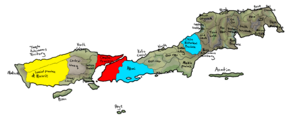Okriti Federated Government
The Federative Republic of Okrit is the official formalized government that holds de facto political control over the islands of Okrit. The Federative republic was officialized in 24PC, as a restructuring of the Aakar Orit led government founded in 7PC.
History
Prior to 24PC, Okrit had an entirely informal structure of governance. Control of the islands was imposed by Aakar Orit and his respective political and economic associates through economic arrangements with local community leaders, militias and mercenary organizations. This was maintained through Orit's monopoly on economic access and communication with eastern powers such as Akaria. After having solidified de facto control through securing access to modern firearms, Okriti governmental structure was formally engaged on March 8th 24PC alongside a national industrialization program. Previous associates were transitioned into respective governmental seats and the various sections of the government were created and staffed.
The first Dakma elections began on May 1st 29PC, with the presidential selection set to begin in September of the following year.
Structure
Okrit is Federal Republic lead by a President. The President presides of a parliamentary council of 40 seats, representing the 40 semi-autonomous provinces, 5 of which are entitled to special privileges as autonomous zones. The highest levels of government besides the president, are the 40 seat parliament of the Dakma and the 15 seat presidential advisory board.
The Dakma
The Dakma is a council of 40 provincial representatives who are integral to the process of passing laws and electing the Okriti President.
Provincial structure
-
The Advisory Board
The Advisory Board consists of 15 members of state from various sections of the government, 8 of which being members of the Dakma.
List of provinces

| Province Name | Current governor | Primary Ethnicity | Provincial Capital | Population |
|---|---|---|---|---|
Election history
-